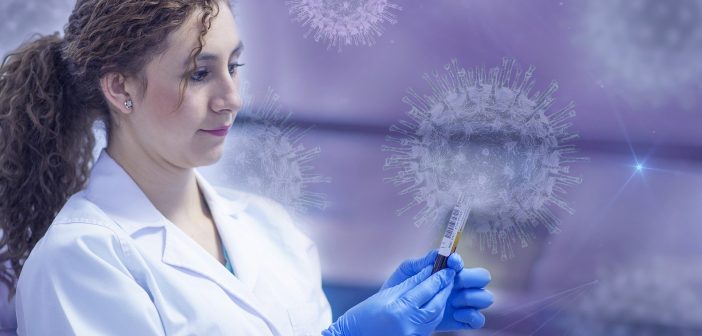Freelance medical writer and researcher for Kolabtree, Mahasweta Pal, writes about the organizations leading COVID-19 coronavirus research and vaccine development, including pharma companies and academia-industry collaborations.
The Director of the National Institute of Allergy and Infectious Diseases, Dr. Anthony Fauci, currently leading the United States’ coronavirus response team, stated that COVID-19 will not be limited to the present outbreak and hinted at the virus’ capability to occur as a potential seasonal problem. His press address at the White House last week placed immense significance on the development of a vaccine and if possible, new drugs to treat moderately severe cases of the disease. This week, the number of deaths neared 50,000 globally with Italy, Spain, and the United States recording 27000+ deaths. Needless to say, the need for more robust healthcare R&D has never been higher. The murkiness in the current situation is multifactorial, as the importation of drugs from other countries including China was halted and the availability of ventilators diminishes.
Amidst the lockdowns or industrial shutdowns to curtail the contagion, the academic community and healthcare researchers have been pulling in available resources together to meet the ever-rising demand for vaccines, medications, diagnostic kits, personal protective equipment, and other epidemic-fighting requirements. Here, I list some of the key developments that occurred in the past months to counteract the COVID-19 pandemic.
COVID-19 research: Molecular biology & pathogenesis
Since the upbeat chatter about the coronavirus emerged in December last year, the novel coronavirus (SARS-CoV-2) has been the epicenter of scientific research whilst wreaking havoc in more than 190 countries. Its origin was speculated to be from bats and more recently, from a rare mammalian species called pangolins in China. The pathogen causing COVID-19 is the seventh coronavirus that infected humans, after HCoV‐OC43, HCoV‐229E, HCoV‐NL63, HCoV‐HKU1, MERS-CoV, and SARS-CoV, of which the first 4 are associated with mild respiratory distress/infections while the last two have caused epidemics in Middle-Eastern Asia and Asia, Europe, North and South America in the last decades, respectively. Characterized by an enveloped, positive‐sense, and single‐stranded RNA structure similar to all human-infecting coronaviruses, SARS-CoV-2 shares an almost similar lifecycle as SARS-CoV using the angiotensin-converting enzyme-2 (ACE2) receptor for entering human cells.
The lifecycle of SARS-CoV-2 starts when the S protein is adjacent to the host cell’s ACE2 receptor. This enveloped spike-like (S) protein represents the virus’ most alarming, determinant feature that governs its pathogenicity; the S protein is composed of 2 domains S1 and S2 that enable the viral body to bind to the ACE2 receptor and fuse with the cell membrane. This S protein is densely glycosylated and has a 10 to 20-fold higher affinity for the ACE2 receptor than SARS-CoV. The cell-membrane fusion between the host cell ACE2 receptor and S protein involves significant structural rearrangements to establish a stable post-fusion conformation, which is followed by viral RNA replication, transcription, and creation of a viral-protein rich genome. The viral proteins then enable the transmission of virions through the vesicles of the endoplasmic reticulum-Golgi complex (ERGIC).
The mechanism of SARS-COV-2 transmission thus highlights the high-risk group primarily comprising cardiovascular disease patients on ACE2 inhibitor and angiotensin receptor blocker (ARB) medications, because these medications mediate the creation of a large pool of ACE2 receptors in the circulatory frameworks. Another significant insight is that the S protein is being used as the target for potential vaccines, antibodies, monoclonal antibodies, and pharmaceutical treatments. Ongoing research aims to answer key questions regarding the variety of pathogenic strains of SARS-COV-2, its genetic similarities with other enveloped, single-stranded viruses, and the mutational abilities of its receptor-binding domains.
Preclinical and Clinical Testing of Repurposed Drugs
Currently, healthcare workers are utilizing crucial anti-malaria medications such as hydroxychloroquine and chloroquine to treat mild to moderate COVID-19 cases. However, the pandemic task forces have some reasons for cheer as Gilead Sciences and Roche leading phase III trials on anti-SARS-CoV-2 treatments with anti-HIV, anti-malarial, and against the SARS-Cov-2 pathogenesis.
1. Gilead Sciences
Gilead Sciences, a company with a large portfolio of antiviral therapies, reported early data on Remdesivir, which failed to show efficacy against Ebola previously but showed promising activity against SARS-Cov-2. Currently, 5 trials in the European Union are testing the safety and antiviral activity of remdesivir, apart from the SOLIDARITY 4-treatment Trial conducted by the World Health Organization (ISRCTN83971151). The main outcome measures of the SOLIDARITY trial include reducing the need for ventilation in severe cases and preventing mortality.
Three of Gilead’s self-sponsored clinical trials on Remdesivir are underway in multiple European countries, while the Discovery trial in France tested 4 treatment combinations based on Standard of care versus remdesivir, lopinavir/ritonavir, Hydroxychloroquine and lopinavir/ritonavir (anti-HIV protease inhibitors) and interferon-β. This trial reported the superior activity of HCQ+LOP/RIT in a 28-day period. The promising early results of Remdesivir’s activity lead to more expanded testing by the US government (2 multi-center trials) with main outcomes monitored over a preliminary 15-day period since March 20, 2020. The COVID-Tox trial by Gilead is focusing on Remdeisvir’s effects of reducing the rate of renal failure and heart failure-induced fatalities.
2. Roche
Roche has started trials in Italy and France where the infection rates surged in March. The investigators are placing their bets on Tocilizumab, an approved treatment for rheumatoid arthritis and cytokine response syndrome (CRS) since the Lancet reported that severe COVID-19 patients developed CRS after hospitalization, which can lead to mortality. Tocilizumab is also under trials with Favipiravir, a new anti-flu drug that showed reasonable effectiveness in clinical trials conducted in China.
3. AbbVie
AbbVie’s anti-HIV agents, namely Lopinavir and Ritonavir were debated among scientists regarding their efficacy. While a small sample study in China failed to show effectiveness against SARS-CoV-2, this combination of RNA-protease inhibitors remains well-established as effective against previous strains of coronaviruses, namely MERS-CoV and SARS-CoV. Thereafter, the World Health Organization announced the launch of the SOLIDARITY trial, wherein Gilead’s Remdesivir, hydroxychloroquine and chloroquine, Lopinavir/Ritonavir plus interferon-β will be tested on a global cohort, including Canada, France, Spain, Norway, Russia, and Switzerland. Earlier, the promising Lopinavir/Ritonavir combination was tested aggressively in China, South Korea, and Hong Kong in combination with Ribavirin, interferon-β, and a fixed-dose combination anti-HIV drug ‘Genvoya’. Genvoya is a cocktail containing cobicistat, elvitegravir, emtricitabine, and tenofovir, which was tested in combination with Ritonavir to observe whether treatment without supplemental oxygenation and ICU admissions was possible as the shortages of ventilators and ICUs reached unprecedented levels. Ascletis Pharma, the Chinese company that manufactured Genvoya reported last month that in this Phase IV trial comprising 11 COVID-19 patients, 10 had been discharged with moderately controlled symptoms and deemed as disease-free over a 30-day period.
4. Sanofi & Regeneron
Sanofi and Regeneron are conducting a Phase II/III trial enrolling severely infected COVID-19 patients for testing Sarilumab, an interleukin-6 receptor inhibitor that showed anti-inflammatory responses to severe COVID-19. The trial is underway in Italy, Spain, Germany, France, Canada, Russia, and the United States, which have been massively impacted by the pandemic. Sarilumab is expected to show efficacy in ameliorating severe respiratory distress syndrome and related life-threatening complications. The trial is testing whether one intravenous dose can prevent fatalities, reduce the viral load, fever, and control the need for oxygenation in severe cases of the disease over 15-day periods. Other trials by the University of California Davis and the University of Chicago are conducting trials to test if sarilumab with Remdesivir is effective in preventing the need for ventilation in severe cases of COVID-19 and to check the efficacy of different doses of sarilumab, respectively.
5. CDC
The CDC has stated that to date, hydroxychloroquine and chloroquine, which are approved products used to treat malaria and some inflammatory diseases, were able to show strong anti-SARS-CoV-2 activity in a Chinese cohort, especially when combined with azithromycin for treating mild to moderate cases in almost all countries affected by the pandemic. In addition, various approved treatments including corticosteroids and non-steroidal anti-inflammatory drugs, are listed to have significant clinical potentials against SARS-CoV-2 such as methylprednisolone per WHO’s list of off-label treatments under trial. One trial in Belgium is investigating the activity of sargramostim (an immunomodulatory drug) for improving oxygenation and outcomes in COVID-19 complicated with acute hypoxic respiratory failure.
Novel treatments for COVID-19
At least 50 biopharma companies have grabbed a spot in the drug development and discovery landscape including Takeda, Eli Lilly, and Regeneron. The pandemic has spurred a bandwagon of key collaborations in North America, Europe, and Asia, which range from viral gene manipulation, B-cell therapies, viral-neutralizing antibody platforms, and also led to amendments in existing collaborations to accommodate new vaccine/treatment discovery.
(a) Eli Lilly
Eli Lily has partnered with Canada-based AbCellera to develop antibody treatments using blood samples from Covid-19 survivors. AbCellera has identified 500+ antibodies developed in a patient’s body post exposure with SARS-CoV-2, which they are currently exploring to produce functional antibody-based drugs. Speed and accuracy of the antibody screening process remains key to the success of these efforts.
(b) Regeneron
Regeneron expanded its collaboration with BARDA-The Department of Health and Human Services’ Biomedical Advanced Research and Development Authority (BARDA) with the intent to discover monoclonal antibodies based on its Mab discovery platform VelocImmune, part of the company’s VelociSuite technology, which had earlier been used to develop anti-Ebola and anti-MERS-CoV treatments. Regeneron’s tech platform is promising because it was able to reduce development timelines from years to months and remarkably improved the preclinical- and clinical-scale manufacturing processes. Scientists of the biotech company have already isolated a large number of gene sequences that they aim to use for developing the monoclonal antibody bank.
(c) Takeda
Takeda is investigating the capabilities of using convalescent plasma-based therapies by evaluating infected patients as was traditionally practiced during the Spanish Flu epidemic in 1918. Takeda is placing its bet on hyper-immunoglobins which have shown aggressive, effective responses against severe acute viral respiratory infections and would not pose manufacturing or patent-related challenges. The anti-SARS-CoV-2 polyclonal hyperimmune globulin (H-IG) concentrates the pathogen-specific antibodies from the patient-derived plasma and then be transferred to another infected patient such that it initiates immune reactions in the new patient. In the US, survivors have already started donating blood plasma to those struggling with the symptoms. Recently, the USFDA issued a fresh guidance document regarding the procurement of fresh convalescent plasma from COVID-19 patients for emergency use while clarifying that it is not an approved treatment yet.
(d) Amgen
Amgen is looking forward to discovering and developing fully human neutralizing antibodies targeting SARS-CoV-2 that can treat or stimulate immunity for COVID-19. The drug major, in collaboration with Adaptive Biotechnologies- an in vitro-diagnostics company- is keen to utilize gene sequence data from COVID-19 patients and apply its globally renowned antibody engineering and manufacturing capabilities to provide novel treatments against SARS-CoV-2. The collaboration is based on the specialized expertise of Amgen’s subsidiary based in Iceland, deCODE Genetics which would provide large scale data of COVID-19 testing and identified survivors that developed antibodies against SARS-CoV-2.
COVID-19 Vaccine Development
Similar to the drug development landscape for COVID-19, various companies started preclinical testing to develop preventive or therapeutic vaccines. The advancements predominantly include mRNA vaccines followed by combination vaccines, genetic vaccines, and re-engineered pneumonia vaccines. Here are some of the notable efforts with regard to novel coronavirus research and vaccine development:
(a) In the crowded race to develop immunizations against SARS-COV-2, Johnson and Johnson is working on engineered adenovirus vector (Ad26 vector)-based vaccines, which have been preclinically tested and enter Phase I trials in September after selecting stable constructs of the vaccine. The company is focussing on the Adenovirus 26 vector because this is a nonreplicating viral vector that is absent in human genomes and can initiate the production of neutralizing antibodies. The company aims to start using the vaccine under the ‘Emergency Use Application’ regulatory clause, Paul Stoffels, J&J’s Chief Scientific Officer said.
Similarly, in the United Kingdom, the ChAdOx1 nCoV-19 vaccine based on an adenovirus vaccine vector (ChAdOx1) developed at Oxford’s Jenner Institute would be commencing clinical testing on patients with and without pre-existing conditions. The vaccine contains the genetic sequence of the S protein inside the ChAdOx1 construct and is expected to initiate adaptive immunity responses inside the susceptible patients. It was inspired by those developed previously for Middle East Respiratory Syndrome (MERS).
(b) Significant progress was reported in April 2020 from the University of Pittsburgh School of Medicine regarding a vaccine candidate that initiated antibody development in humanized mice models. The potential vaccine is a recombinant protein targeting the S protein delivered by microneedle arrays, which showed remarkable immunogenicity evident after a 14-day period. This research established the long-term immunogenicity of recombinant SARS-CoV-S1 and rSARSCoV-S1fRS09 immunogens. The research also emphasized the effectiveness of using microneedle array mediated immunization instead of traditional intramuscular or subcutaneous needle injections, in particular, the microneedle arrays deliver vaccine components to a defined 3D space within the skin microenvironment resulting in very high vaccine concentrations with relatively low dose antigen delivery.
(c) The National Institute of Allergy and Infectious Diseases has started a phase I trial testing mRNA-1273, an mRNA vaccine co-developed with Moderna Therapeutics. mRNA vaccines are considered high potency, rapidly producible, cost-effective, and safer alternatives to traditional live attenuated vaccines. Viral mRNA vaccines are limited by their delivery to infected cells. However, mRNA-1273 has been designed to be delivered by Lipid nanoparticle dispersion to inhibit the cell membrane fusion between the S protein and host cell ACE2 receptors. This phase I open-label trial I enrolling healthy adults with no reported pre-existing conditions.
(d) Pfizer and BioNTech, a German company focussed on developing mRNA-based treatments, are working to develop a potential mRNA coronavirus vaccine. The vaccine candidate, BNT162, aims to prevent COVID-19 in patients by targeting the pathogen using either of the four mRNA formats developed by BioNTech based on uridine-containing mRNA, nucleoside modifications, and self-amplifying mRNA, which have the final goal of increasing the immunogenicity in the body. The companies are preparing to start clinical trials with the vaccine in April 2020.
(e) Another academia-industry collaboration between the Singapore-based Duke-NUS Medical School and US-based Arcturus Therapeutics focusses on the development of anti-SARS-CoV-2 mRNA vaccines based on its proprietary platform combining self-replicating RNA with nanoparticle non-viral delivery to initiate therapeutic protein production inside the human body. Preliminary test evidence that this self-replicating RNA-based therapeutic vaccine triggers rapid and prolonged immunity against infectious pathogens, which would be investigated for COVID-19.
(f) The World Health Organization reports that 40+ vaccine candidates against SARS-COV-2 are under preclinical development and testing, comprising DNA vaccines based on nonreplicating viral vectors, DNA plasmid vaccines, recombinant peptides, inactivated viral vaccines, virus-like particles, receptor-binding protein-based proteins, and live attenuated vaccines that are under investigation at various academic institutions worldwide.
Experts within the medical research and healthcare industry have forecast that it will not be earlier than January 2021 when the first vaccine candidates are available for clinical application. Regarding the requirement of personal protective equipment, the surging demand has prompted the development and distribution of protective masks and hospital-use gowns by designer apparel band ‘Ralph Lauren’ and American footwear brand ‘Under Armour’.
On the other hand, the pandemic’s dire consequences have led the European Commission to consider postponing the implementation of the new EU MDR by a year. The MDR was to take effect on May 26, which may be practically challenging considering the current burden on the healthcare facilities and medical device companies. Stella Kyriakides, Commissioner for Health and Food Safety, said in a statement: “Our priority is to support Member States to address the coronavirus crisis and protect public health as powerfully as possible – by all means necessary. Any potential market disruptions regarding the availability of safe and essential medical devices must and will be avoided.” The proposal also notes the complexity of MDR, adding that “it is very likely that the Member States, health institutions, economic operators and other relevant parties will not be in a position to ensure the proper implementation and application of that Regulation from 26 May 2020 as it provides for.”
Meanwhile, the USFDA has approved the first serological test developed by a North-Carolina based company under the ‘Emergency Use Authorization’ policy. The test can detect SARS-COV-2 antibodies, immunoglobulin M (IgM) and immunoglobulin G (IgG) that are generated as part of the human immune response to the virus. Although FDA recommends that serological test results should not be considered the sole basis to diagnose or exclude a coronavirus infection, the test can help in detecting the number of persons who have had SARS-COV-2, even if they did not show symptoms. Various companies await the authorization from the regulator of their potential COVID-19 diagnostic tests as the evidence of their unprecedented demand comes to the fore.
The author wishes to honor healthcare workers working at the frontline of the pandemic. She also thanks Dr Paramita Mukherjee Ghosh for helping with the research and providing updates as the grassroots level.
Need to consult an expert on coronavirus? Hire highly qualified researchers and scientific consultants on Kolabtree. Post your project for free.
Coronavirus experts | COVID-19 researchers | Infectious disease experts | Freelance scientific writers | Freelance literature search experts







